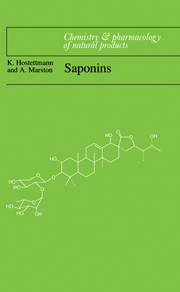Book contents
- Frontmatter
- Contents
- Glossary
- 1 Introduction
- 2 Occurrence and distribution
- 3 Analysis and isolation
- 4 Structure determination
- 5 Triterpene saponins – pharmacological and biological properties
- 6 Steroid saponins and steroid alkaloid saponins: pharmacological and biological properties
- 7 Commercially important preparations and products
- Appendices
- References
- Index of Latin names
- General index
7 - Commercially important preparations and products
Published online by Cambridge University Press: 19 October 2009
- Frontmatter
- Contents
- Glossary
- 1 Introduction
- 2 Occurrence and distribution
- 3 Analysis and isolation
- 4 Structure determination
- 5 Triterpene saponins – pharmacological and biological properties
- 6 Steroid saponins and steroid alkaloid saponins: pharmacological and biological properties
- 7 Commercially important preparations and products
- Appendices
- References
- Index of Latin names
- General index
Summary
From the very earliest times, saponin-containing plants have found widespread application in the treatment of various ailments – coughs, syphilis, rheumatism, gout, just to mention a few. Their use as panaceas has also been recorded. In Europe, certain saponin preparations have been employed for centuries. Of these, the most important include: Saponariae radix, Hippocastani semen (Weil, 1901), Primulae radix, Hederae helicis herba (or folium), Senegae radix and Liquiritiae radix. The Rote Liste has over 200 preparations which contain saponins. The most frequently employed are Primulae radix, Senegae radix, Liquiritiae radix, Hippocastani semen, Hederae helicis folium, Ginseng radix, Hydrocotylis herba and Rusci radix. The pharmacologically active saponins from these sources have now largely been characterized and their activities confirm the medicinal properties of the respective plant drugs. Thus, aescine, primula saponin andα-hederin exhibit antiexudative effects; primula saponin, senegin, glycyrrhizin and gypsophila saponin exhibit expectorant effects; saponins from ginseng and Eleutherococcus are adaptogenic.
Synthetic Pharmaceuticals have, to a certain extent, replaced many of the earlier saponin-containing preparations, but, even so, a number of saponin drugs still assume a high degree of importance (Gerlach, 1966; Schantz, 1966). It must be stressed that most of the saponin preparations used in phytotherapy are either extracts or mixtures. In many of the studies on these preparations, the exact saponin composition is not known and extrapolation of the activities of monosubstances to the saponin-containing product may be risky. In view of this problem, there is a tendency to move towards the use of pure substances because they can be directly analysed and standardized.
- Type
- Chapter
- Information
- Saponins , pp. 307 - 341Publisher: Cambridge University PressPrint publication year: 1995



